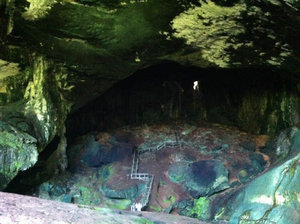Advertisement

 Great Cave
Great Cave
So-named because of its vast entrance, measuring some 200+m across and 60m in height. This is where the bulk of the harvesting is done.After the brief sojourn to the Kelabit Highlands, I took the short flight back to Miri, and continued with another 2h bus ride to Batu Niah, the nearest town to the Niah National Park, yet another one of Malaysia' Unesco World Heritage Sites, and home to its famous multi-millenia-year old limestone caves.
Of course Batu Niah isn't exactly right at the National Park's doorstep, and so it was a hot and humid 3km hike first to the park entrance, followed by another 3km to the caves proper. Apart from being notable and really quite impressive geological relics, these caves have also been home to millions (yes, millions) of swiftlets and bats for decades, if not centuries. Apparently there is some sort of implicit arrangement between the two species, where the bats inhabit the caves during the day, while the swiftlets hunt outside, and the roles reverse at night. So come evening, there are two black "clouds" when the swarms exchange places in a changing of the guard of sorts. I wasn't able to witness it myself, but I imagine it must be some spectacle.
Also unsurprisingly, since the last century, locals have exploited their presence, harvesting the swiftlet's highly-prized

 Boardwalk to the Caves
Boardwalk to the Caves
A serious 30 min 3.1 km hike in the searing heat and humidity.sticky nests (made from their saliva, among other constituents) for birds' nest soup (a Chinese delicacy) and the collective droppings (aka guano) as fertiliser. Even today, it is estimated that up to 70% of the state's birds' nest exports (which can fetch up to USD1000/kg for the highest quality) comes from the Niah caves.
I distinctly remember learning once as a child, that the pricey, sweet dessert that is birds' nest soup, which I had the opportunity to indulge in occasionally, was mostly harvested from this place called Niah in Sarawak, which I of course, as a child, had no clue as to its whereabouts, and which, despite its actual relative proximity to home, remained an exotic locale. And to some extent, every time thereafter when I had the opportunity to eat the dish again, my mind would wander to this mysterious place. So it is with some satisfaction that, decades later, I finally had the chance to see for myself where it all comes from.
Stayed at Niah Caves Hotel.
Advertisement
Tot: 0.193s; Tpl: 0.013s; cc: 10; qc: 52; dbt: 0.1074s; 1; m:domysql w:travelblog (10.17.0.13); sld: 1;
; mem: 1.1mb

 Great Cave
Great Cave
 Boardwalk to the Caves
Boardwalk to the Caves










